Get Your Disc Pain Treated Sooner & Save 77% Off Your Consultation
Disc-Related Back Problems?
Manual Therapies May Be the Solution…
Spinal disc problems such as herniated discs are a leading cause of serious chronic back and neck pain around the world.
In the UK, back pain is the largest single cause of disability and spinal surgery cases are rising sharply, with waiting periods from referral to treatment increasing.
Despite the highly invasive nature of spinal surgery and a lack of evidence to demonstrate its effectiveness for treating disc problems, there seems to be a reluctance to consider manual therapies like chiropractic care, or one of its more developed derivatives like non-surgical reconstructive care as an alternative to mainstream approaches.
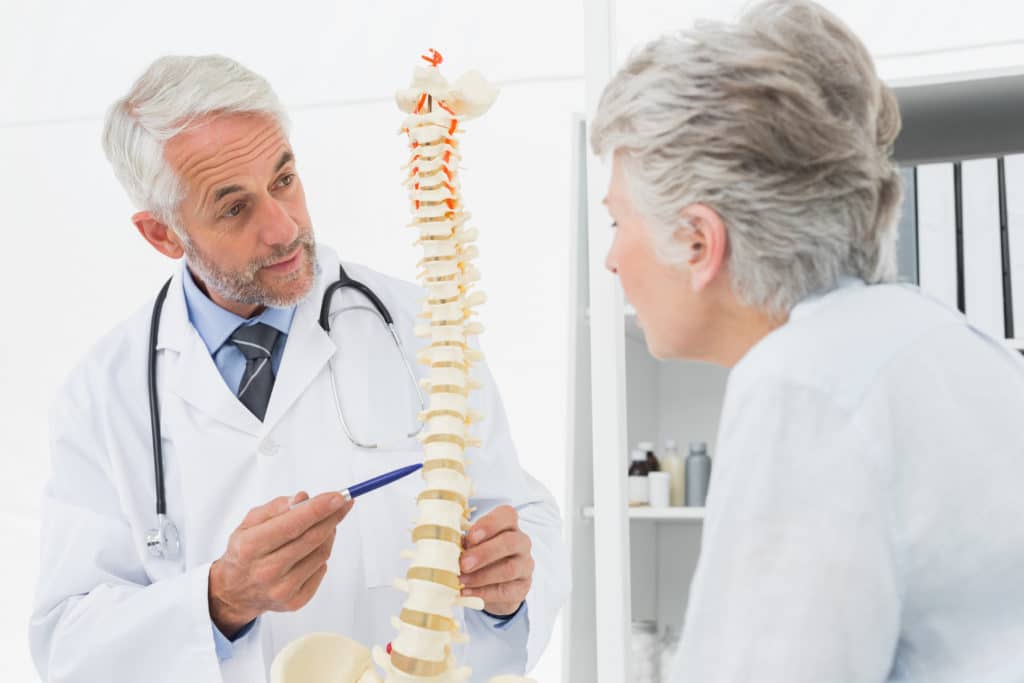
Why is this?
It’s not due to a lack of evidence of the benefits of manual therapies. As you will see from the study summaries that follow, plenty of research backs manual therapies up.
There appears to be a lack of awareness from the general public about the value of chiropractic care and other related therapies for back pain.
The medical establishment is therefore under no pressure to embrace it.
Leave your name and number in the form below or Call Us Now On 01234 340 317
What are spinal disc problems?
Spinal disc problems result from abnormalities in the discs that separate the vertebrae in the spinal column.
These discs are designed to absorb shock. They have a soft spongy or rubbery inner section surrounded by a hard outer coating.
When discs develop problems, potentially debilitating pain can develop. Apart from back pain, typical symptoms include:
– Back spasms
– Sciatica
– Pain in the legs
– Tingling or numbness
– Muscle weakness
– Loss of lower body function
Typical spinal disc-related problems include:
– Herniated discs (also known as slipped discs or prolapsed discs) – where the centre of the disc swells under stress and breaks out of the tough outer covering.
– Extruded discs – where the nucleus of the disc bulges and squeezes through a weakness or tear in the outer covering but the soft material remains intact.
– Degenerative disc disease – this term is usually used for age-related disc problems resulting from changes to the condition of the bone that forms the disc.
– Spondylolisthesis – where one of the lower vertebrae slips forward onto the bone directly beneath it. When this is particularly severe, it is called spondyloptosis.
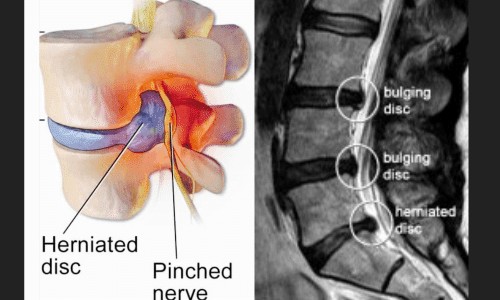
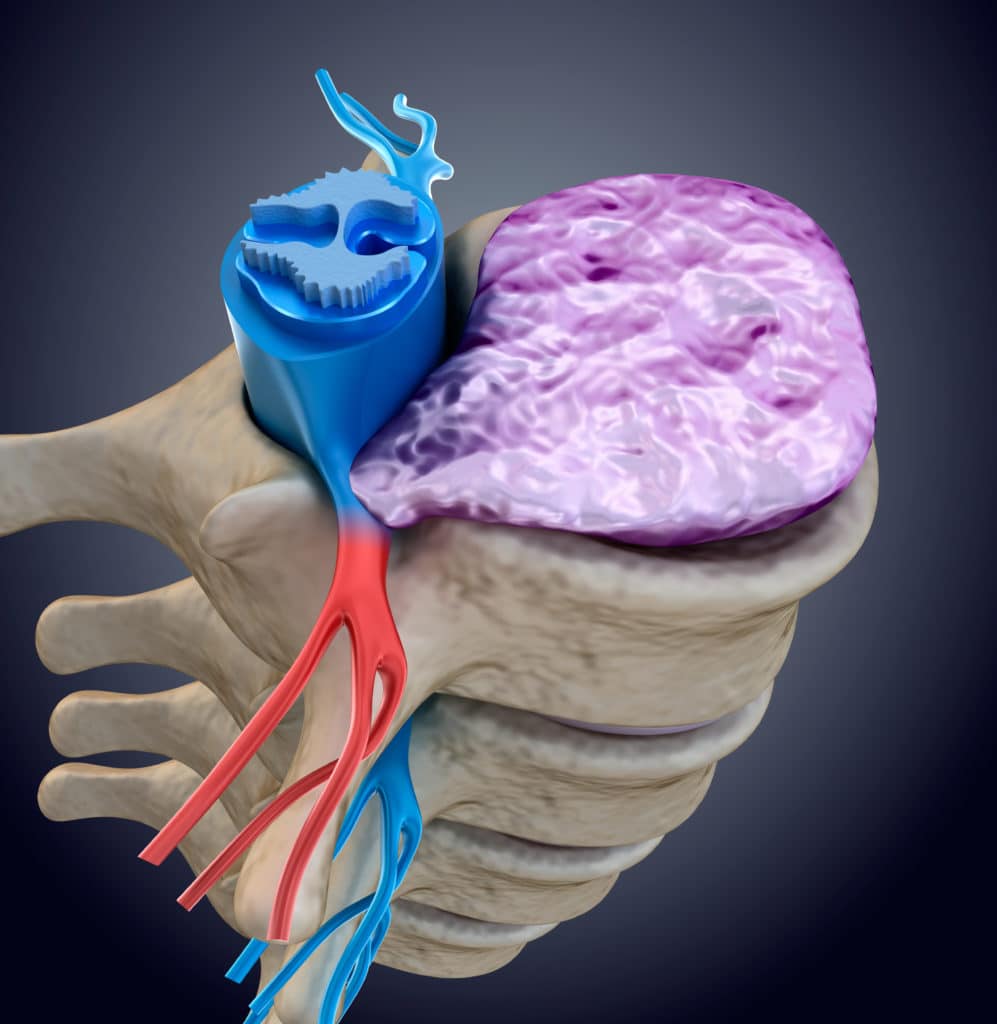
When a disc is caused to bulge or herniate, it can impinge on surrounding nerves (sometimes referred to as “radiculopathy”) and may cause extreme “radicular” pain.
Problems are usually diagnosed by x-ray or MRI.
Around 90 percent occur in the lumbar region (lower back), largely because of the extra pressures exerted there. This is usually termed lumbar disc herniation (LDH).
What is the mainstream medical approach to disc problems like herniation?
For people with spinal disc issues, the pain can develop and intensify if left untreated. This can lead to loss of mobility, quality of life, and ability to work.
The conventional approaches to serious spinal disc problems like herniated discs usually involve one of two options:
– Nothing can be done and you must manage the pain with over-the-counter or prescription painkillers/injections
– You need surgery
Neither of these is ideal, of course.
Being consigned to a lifetime of painkilling medication exposes patients to a wide variety of potential side effects.
The NHS itself notes “ineffective but costly injections” and says “there are large numbers of patients being given injections with low evidence of effectiveness.”
Surgery is time-consuming for the patient (there are long waiting lists on the NHS), inconvenient (a long recovery period), and there are no guarantees of success. In fact, the success rate of back surgery is quite poor.
Again, on the NHS website, we read: “there are a significant number of treatments with a poor evidence base.”
Leave your name and number in the form below or Call Us Now On 01234 340 317
What role do manual therapies have to play?
Manual therapies are sometimes also called manipulative therapies. They can be used to treat musculoskeletal problems, such as back pain.
In general, manual therapies are carried out by physiotherapists and chiropractors, who use their hands to put pressure on muscle tissue and to manipulate joints to mobilise them.
Manual therapies have several key advantages over the mainstream approaches to back pain resulting from disc problems:
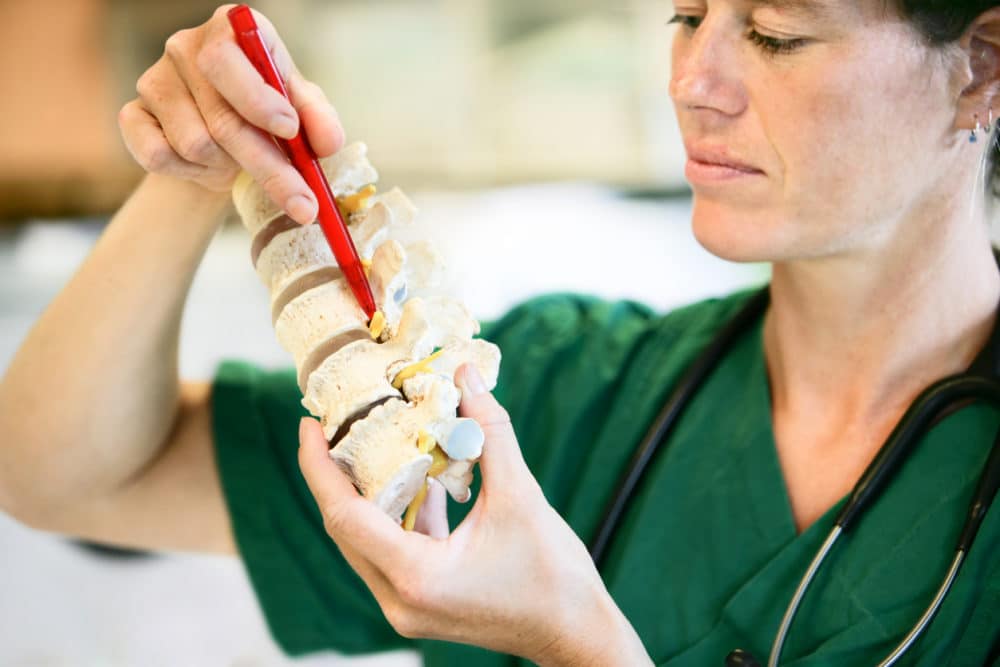
– They aim to address the root cause of the problem rather than simply managing the symptoms
– They involve no medication
– Most have no side effects
– There are no waiting lists
– Most treatments are cost-effective
Given these benefits, it’s surprising that manual therapies are not recommended for more patients with disc-related back pain.
It’s not from lack of evidence…
Evidence of the beneficial effects of manual therapies
Over the years, many studies have indicated the effectiveness of manual therapies as a treatment for disc-related back pain.
As far back as 1969, a study published in the British Medical Journal looked at the reduction of lumbar disc prolapse by manipulation.
Though manual therapies have been used for many centuries to treat painful musculoskeletal conditions, this was the first study to clearly demonstrate that treatment by manipulation could relieve the symptoms of lower back pain and leg pain, and reduce the size of prolapse.
“The results of this study suggest that small disc protrusions were present in patients presenting with lumbago and that the protrusions were diminished in size when their symptoms had been relieved by manipulations.”
More recent studies have added to the body of evidence for the treatment of herniated discs with manual therapies.
Following is a summary of the key studies and their findings/conclusions:
1999: A 31-year old man with a large disc herniation and severe low back pain and leg weakness (despite taking pain medication) was treated with targeted exercise and later a series of chiropractic manipulations and other therapies. He was able to return to work less than a month later and was asymptomatic after 50 days and 20 sessions.
Conclusion:
“This case demonstrates the potential benefit of a chiropractic rehabilitation strategy by use of multimodal therapy for lumbar radiculopathy associated with disk herniation.”
2003: A retrospective analysis of the files of 39 patients with cervical radiculopathy treated by a practitioner with flexion-distraction manipulation and some form of adjunctive physical medicine modality. The study revealed a statistically significant reduction in pain.
Conclusion:
“The results of this study show promise for chiropractic and manual therapy techniques such as flexion distraction, as well as demonstrating that other, larger research studies must be performed for cervical radiculopathy.”
2004: A 38-year-old male with a lumbar disc herniation (including radiated pain below the knee) received chiropractic spinal manipulation and exercise rehabilitation. He reached a level of functional biomechanical stability over 15 weeks.
Conclusion:
“This case demonstrates that with proper management, rehabilitation of a patient with disc herniation can be reached in a short duration of time.”
2004: A 23-year-old woman suffered from chronic unremitting symptoms of lower back pain and left leg pain. She was treated five years prior, without relief. She was found to have a moderate posterior disc protrusion with degeneration and was treated with chiropractic adjustments and postural exercises. The patient responded well with a complete resolution of her symptoms.
Conclusion:
“Further study is warranted into the treatment of chronic low-back pain with chiropractic biophysics methods.”
2004: A qualitative systematic review of the risk of spinal manipulation in the treatment of lumbar disk herniations (LDH) estimated that the risk of spinal manipulation causing a clinically worsened disk herniation or CES in a patient presenting with LDH as less than one in 3.7 million.
Conclusion:
“The apparent safety of spinal manipulation, especially when compared with other accepted treatments for LDH, should stimulate its increased use in the conservative treatment plan of LDH.”
2004: A 60-year-old healthy male had a three-week history of right buttock and calf pain. He was treated with a lumbar epidural and nerve root injection, as well as manipulation, physical therapy, and strengthening exercises. His pain rating on presentation was 73%, Upon discharge, the pain rating was 0%. He returned to running, which was his primary goal.
Conclusion:
“This case demonstrated a positive outcome using a multidisciplinary approach in a patient diagnosed with a FLLIDH. He obtained his goals and his function was fully restored.”
2005: A 33-year-old male with disc herniation had been recommended surgery, with gradual onset of lower extremity symptoms, diminished fitness level, and weight gain over a four-year period. With a combination of acute inflammation control, closed disc reduction, and remedial therapeutic (passive joint movement) care, patient compliance was achieved with a positive long-term outcome.
Conclusion:
“This case illustrates common clinical components of care associated with disc herniation case management, the potential of conservative care, and the benefits of combining manual therapy and rehabilitative exercise.”
2006: A 57-year old man with low back pain that radiated to his leg, with lumbar spinal cord and nerve root impingement, was treated effectively with chiropractic spinal manipulation, physical therapy modalities, and rehabilitative exercises.
Conclusion:
“There is an abundance of published reports describing treatment of disk injury, low back pain, and spondylolisthesis with a variety of manipulative methods. However, this appears to be the first case reported in indexed literature of a progressive multilevel lumbar disk injury with concomitant spondylolisthesis and spondyloptosis.”
2006: A randomized double-blind trial compared active and simulated manipulations in treating low back pain and sciatica in 102 patients aged 19-63. Manipulations appeared more effective on the basis of the percentage of pain-free cases and number of days with pain. There were only two treatment failures and no adverse events.
Conclusion:
“Active manipulations have more effect than simulated manipulations on pain relief for acute back pain and sciatica with disc protrusion.”
2008: A 40-year-old woman with two-level cervical disk herniation with radicular symptoms was conservatively treated with chiropractic care including high-velocity, low amplitude (HVLA) manipulation. The result was a complete resolution of her symptoms within 90 days and no return after one year.
Conclusion:
“This case describes the clinical presentation and course of a patient with multilevel large herniated disks and associated radiculopathy who was treated with HVLA manipulation and other conservative approaches and appeared to have good outcomes.”
2008: A retrospective review looked at 162 patients with cervical and lumbar radiculopathy who were treated with a chiropractic treatment along with neuromobilization and exercise stabilization. 85.5% of patients had resolution of their primary subjective complaints.
Conclusion:
“The conservative management strategy we reviewed in our sample produced favorable outcomes for most of the patients with radiculopathy. The strategy appears to be safe. Randomized clinical trials are needed to separate treatment effectiveness from the natural history of radiculopathy.”
2008: A retrospective cohort study of six patients with a medical history of lumbar herniated or bulging disk with a pain level minimum of 8/10, and/or history of sciatica or other radicular pain. All patients received a multimodal spinal rehabilitation treatment with vibration traction therapy, with positive and statistically significant outcomes.
Conclusion:
“The multidimensional outcomes reported here were achieved after a structured protocol of multimodal chiropractic rehabilitation. It is unknown which, if any, of these procedures were responsible for the observed improvements.”
2008: In a study of 60 patients with acute leg pain and low back pain caused by lumbar disc herniation (LDH), there were significant reductions in pain and disability scores between baseline and follow-up periods. There were also significant reductions in the size of the herniated mass on magnetic resonance imaging after treatment.
Conclusion:
“This study showed that traction, ultrasound, and LPL therapies were all effective in the treatment of this group of patients with acute LDH…conservative measures such as traction, laser, and ultrasound treatments might have an important role in the treatment of acute LDH.”
2009: A prospective observational cohort study was conducted on 49 patients at a multidisciplinary clinic that includes chiropractic and physical therapy services. The mean duration of complaint was 60.5 weeks. The mean self-rated improvement at the end of treatment was 77.5%. Improvement was described as “good” or “excellent” in nearly 90% of patients.
Conclusion:
“Management based on the decision rule yielded favorable outcomes in this cohort study. Improvement appeared to be maintained over the long term.”
2014: For 148 patients (aged between 18 and 65 years) with disc herniation, high-velocity, low-amplitude (HVLA) spinal manipulation resulted in “significant improvement for all outcomes at all time points”. These “time points” were 2 weeks, 1, 3, and 6 months, and 1 year after the first treatment. Importantly, no adverse events were reported.
Conclusion:
“A large percentage of acute and importantly chronic lumbar disc herniation patients treated with chiropractic spinal manipulation reported clinically relevant improvement.”
A viable alternative to surgery or doing nothing
The options for non-surgical treatments of disc-related back pain are supported by study after study over the past 20 years.
This, coupled with the negligible risk of adverse side effects associated with conservative treatments such as manual therapies, indicates great potential for chiropractic care and physical therapies.
Yet, even now, they are recommended to the few and ignored by the many.
For this to change, the medical establishment must start to take manual therapies more seriously and recognise the important role they can play in treating disc herniations and other similar back problems.
Spine, Body & Health Treatment & Therapy
Getting your Disc Pain treated is simple. It all starts with a consultation with one of our spinal specialists at Spine, Body & Health.
This consultation is, in our opinion, the best in the area as it gives complete clarity and understanding about why you are truly in pain. With this information we can then give you a structured and personalised recommendation of care to help treat your nerve pain.
Click the button below to start your journey with Spine, Body & Health.
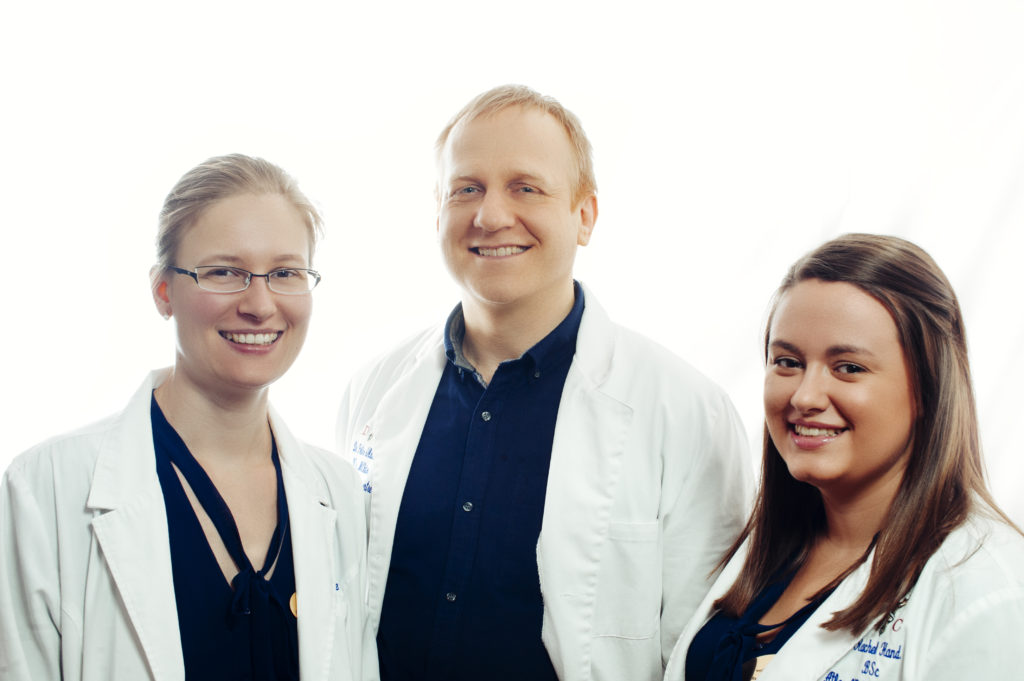
Save 77% Off Your Consultation
Click the Button or Call Us Now on 01234 340317
We Hope This Has Been Useful…
As you can see from the information above, there are many types of disc problems and many potential solutions from home remedies to seeking professional help.
If you do want to discover the cause of your disc problems and you live in Bedford, Milton Keynes, Northampton, Wellingborough, Luton or one of the surrounding areas then why not come to Spine, Body & Health for a Consultation. You’ll be in good hands with one of our Spinal Specialists.
Normally Consultations cost £405.00 due to how in-depth and powerful the testing is, however, right now you can get the same consultation for only £93. Enter your name, number and email in the form below and one of our team will give you a call as soon as possible to get your Consultation booked.
*We can only provide this offer to people that live 25 miles or less from the clinic (as determined by Google maps)
Book Your Consultation Today!
If you’re suffering then we want to help.
Fill out the form to the right and one of our team will contact you to get you booked in for your initial consultation.
They will be on hand to answer any questions you have and talk you through how you can save up to 77% off the consultation fee, instantly.
We look forward to meeting you and helping you on your journey!
Dr. Peter Olsson
Fill out this form to receive health news, exclusive discounts and learn how to book your consultation.
We will take a £10 deposit to secure your consultation.
References
JA Mathews and DAH Yates. Reduction of Lumbar Disc Prolapse by Manipulation. British Medical Journal September 20, 1969, No. 3, 696-697.
Serafin Leemann et al. Outcomes of acute and chronic patients with magnetic resonance imaging–confirmed symptomatic lumbar disc herniations receiving high-velocity, low-amplitude, spinal manipulative therapy: a prospective observational cohort study with one-year follow-up. J Manipulative Physiol Ther 2014;xx:1-9.
Christopher J. Hammer. Chiropractic management and rehabilitation of a 38-year-old male with an L5-S1 disc herniation. J Chiropr Med 2004;3:145–152.
Craig E. Morris. Chiropractic Rehabilitation of a Patient with S1 Radiculopathy Associated with a Large Lumbar Disk Herniation. J. Manipulative Physiol Ther 1999;22:38-44.
Simon G. Excoffon and Harry Wallace. Chiropractic and rehabilitative management of a patient with progressive lumbar disk injury, spondylolisthesis, and spondyloptosis. J Manipulative Physiol Ther 2006;29:66-71.
Wayne M. Whalen. Resolution of cervical radiculopathy in a woman after chiropractic manipulation. Journal of Chiropractic Medicine (2008) 7, 17–23.
Santilli V. et al. Chiropractic manipulation in the treatment of acute back pain and sciatica with disc protrusion: a randomized double-blind clinical trial of active and simulated spinal manipulations. The Spine Journal 6 (2006) 131–137.
Kim D. Christensen & Kirsten Buswell. Chiropractic outcomes managing radiculopathy in a hospital setting: a retrospective review of 162 patients. Journal of Chiropractic Medicine (2008) 7, 115–125.
James E. Greathouse Jr. Conservative management of a patient with lumbar disc disease: averting lumbar disc surgery. J Chiropr Med 2005;4:162–176.
Jason S. Schliesser et al. Cervical radiculopathy treated with chiropractic flexion distraction manipulation: a retrospective study in a private practice setting. J Manipulative Physiol Ther 2003;26:e19.
Donald R. Murphy. A nonsurgical approach to the management of patients with lumbar radiculopathy secondary to herniated disk: a prospective observational cohort study with follow-up. J Manipulative Physiol Ther 2009;32:723-733.
Drew Oliphant. Safety of spinal manipulation in the treatment of lumbar disk herniations: a systematic review and risk assessment. J Manipulative Physiol Ther 2004;27:197-210.
Richard E Erhard et al. Far-lateral disk herniation: case report, review of the literature, and a description of nonsurgical management. J Manipulative Physiol Ther 2004;27:e3.
Ian Horseman & Mark W. Morningstar. Radiographic disk height increase after a trial of multimodal spine rehabilitation and vibration traction: a retrospective case series. Journal of Chiropractic Medicine (2008) 7, 140–145.
Phillip Paulk & Deed E. Harrison. Management of a chronic lumbar disk herniation with chiropractic biophysics methods after failed chiropractic manipulative intervention. J Manipulative Physiol Ther 2004;27:e15.
Zeliha Unlu et al. Comparison of 3 physical therapy modalities for acute pain in lumbar disc herniation measured by clinical evaluation and magnetic resonance imaging. J Manipulative Physiol Ther 2008;31:191-198.
The NHS website. The National Back Pain Pathway (Aug 2016). Accessed on 30 Jan 2020: https://www.england.nhs.uk/blog/charles-greenough/
Disclaimer: Every effort has been made to accurately represent all services provided by Spine, Body & Health. There is no guarantee that you will get specific results by working with us. Examples on this site are not to be interpreted as a promise or guarantee.
Your level of success in attaining the results claimed on this site and by our staff depend on several factors, such as your background, motivation, commitment, and actions. Since these factors differ according to individuals I cannot guarantee your success, nor am I responsible for any of your actions. Results may vary.
© Copyright 2023 Spine, Body & Health. All Rights Reserved.
